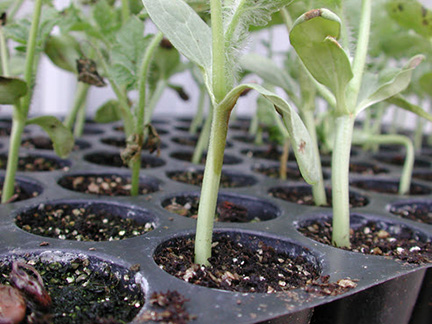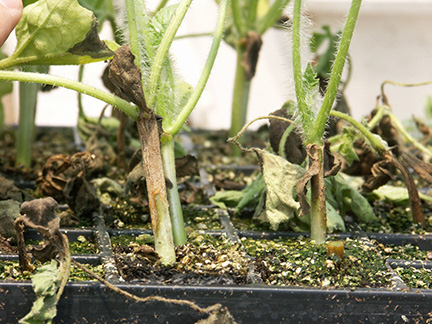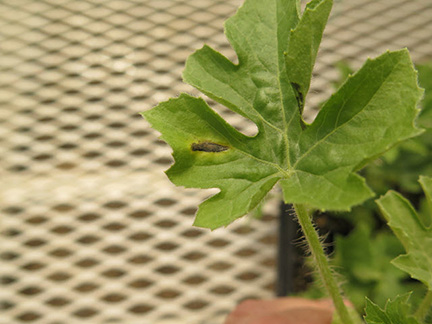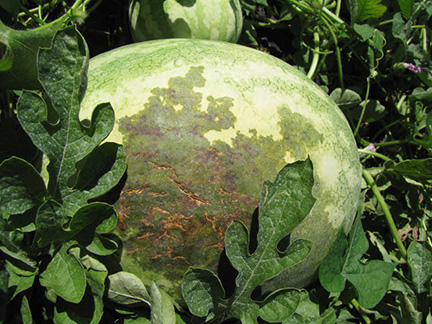Most watermelon growers are in the process of placing transplants in the field. I have received several commercial samples of transplants still in trays prior to out-planting. The two diseases I have observed so far are gummy stem blight and bacterial fruit blotch. Below, I discuss these two diseases as well as management options.
Gummy stem blight on transplant seedlings may be recognized by the watersoaked area of the stem (botanical term: hypocotyl) as shown in Figure 1. The watersoaked area may eventually turn brown and woody. A closer look at the woody area may reveal the small, dark fungal structures of the gummy stem blight fungus (Figure 2). The true leaves of watermelon transplants may also be affected.
The fungus that causes gummy stem blight (Didymella bryoniae) may survive in crop debris, thus overwintering in the field from year to year. This fungus may also survive in seed. It is also possible for the fungus to survive in greenhouse production facilities.
Crop rotations with non-cucurbit crops for 3 years will help to lessen disease severity. Preventive fungicide applications may be scheduled with MELCAST, a weather-based disease forecasting system. Contact fungicides such as chlorothalonil (e.g., Bravo®, Echo®, Equus®, Initiate®) or mancozeb (e.g., Dithane®, Manzate®, Penncozeb®) should be alternated with systemic products such as Luna Experience®, Switch®, Inspire Super® or tebuconazole (e.g., Monsoon®). Not all of these fungicides are labeled for other fungal diseases such as anthracnose. Remember to alternate modes of action by using the FRAC codes of the fungicides. See the Midwest Vegetable Production Guide p. 72 for more information.
The symptoms of bacterial fruit blotch (BFB) can be difficult to recognize on foliage. Leaf lesions may be angular and appear to run along the vein (Figure 3). The lesions may appear watersoaked, especially when viewed on the underside of the leaf. Leaf symptoms of BFB are easily confused with angular leaf spot, a disease that is not often economically important. A laboratory analysis may be required to distinguish these two diseases. The relatively large, oily lesions on fruit are easier to recognize (Figure 4).
In contrast with gummy stem blight described above, the bacteria that causes bacterial fruit blotch (Acidovorax avenae citrulli) does not readily survive in crop residue. The bacterium is known to survive in seed. It is possible that the bacterium may survive in greenhouse production facilities.
Once BFB is detected in the field, applications of a copper product tank mixed with a mancozeb product may help to lessen disease severity. Whether BFB is detected in a watermelon field or not, updated recommendations are to apply copper 2 weeks before first female bloom, at first female bloom and 2 weeks after first female bloom. Additionally, application of the product Actigard® at 2 of the 3 copper application times listed above is recommended. More information about these new recommendations may be found on the VeggieDiseasesBlog or in the Midwest Vegetable Production Guide.
Be sure to inspect seedlings for signs or symptoms of disease. Avoid planting transplants that may be diseased.



